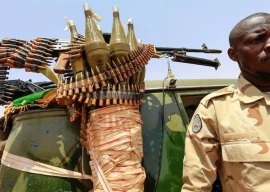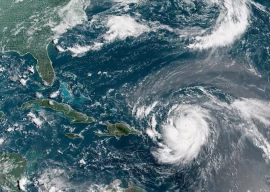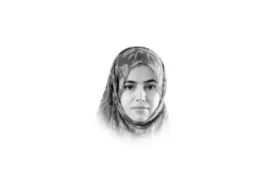
A Taliban spokesman on Twitter claimed the first attack, which killed 14 Nepali security guards working for the Canadian Embassy in Kabul in a massive blast that left their yellow minibus spattered with blood.
However Islamic State's affiliate in Afghanistan and Pakistan released a competing claim in which they named and pictured the alleged bomber, according to the SITE monitoring group, in what would be their most significant attack in the country.
Initial report of today's terrorist attack in Kabul 14 killed and 8 wounded, Police are working to ID victims.
— Sediq Sediqqi 🇦🇫 (@SediqSediqqi) June 20, 2016
An Afghan intelligence source said officials were investigating the IS claim, which was flatly denied by the Taliban.
Afghan delegation arrives in Islamabad to discuss Torkham border skirmishes
The Taliban also claimed a second, smaller blast in south Kabul Monday that the interior ministry said killed one person.
The bombings were followed hours later by an attack on a market in the remote northeastern province of Badakhshan that authorities said killed at least 10 people, with the death toll set to rise.
 Afghan firefighter wash a road at the site of a suicide attack to have hit a minibus carrying foreign security guards in Kabul on June 20, 2016. PHOTO: AFP
Afghan firefighter wash a road at the site of a suicide attack to have hit a minibus carrying foreign security guards in Kabul on June 20, 2016. PHOTO: AFPThe wave of violence comes 10 days after Washington announced an expansion of the US military's authority to conduct air strikes against the Taliban, a significant boost for Afghan forces who have limited close air-support capacities.
Police said the attack on the Nepali guards was carried out by a suicide bomber on foot early Monday on a main road leading east out of the capital towards the city of Jalalabad.
Fourteen Nepali nationals were killed, the interior ministry said in a statement, with nine wounded -- five Nepali citizens and four Afghans.
Afghanistan says Kabul attack was planned by Haqqani network in Pakistan
The Canadian embassy in Afghanistan confirmed the "cowardly" attack in a tweet, and said that it had employed the guards.
The explosion could be heard across Kabul and a plume of smoke seen above the site of the blast on the Jalalabad road, a main route housing many foreign compounds and military facilities.
 Afghan residents walk after security forces blocked a road at the site of a suicide attack to have hit a minibus carrying foreign security guards in Kabul on June 20, 2016. PHOTO: AFP
Afghan residents walk after security forces blocked a road at the site of a suicide attack to have hit a minibus carrying foreign security guards in Kabul on June 20, 2016. PHOTO: AFPMore than two dozen ambulances rushed to the scene, an AFP journalist said, with police blocking off the road. The blast also shattered the windows of nearby shops.
Nepal's prime minister K.P. Sharma Oli said his country "strongly condemns" the killings.
Taliban spokesman Zabihullah Mujahid claimed responsibility for the attack on social media, saying it was "against the forces of aggression" in Afghanistan.
Afghan lawmaker killed in blast at his home in Kabul
The Islamic State claim, which SITE said was released on Twitter and Telegram, named the bomber as Irfanullah Ahmed and pictured him armed and dressed in combat fatigues in front of an IS flag.
The Taliban poured scorn on the IS claim.
"They neither have the capability to carry out attacks in Kabul, and nor are they supported by people. Today's attack was carried out by one of our mujahideen, and Daesh claiming they did it, is baseless and hollow," Mujahid told AFP by phone, using an alternate name for IS.
The Kabul blasts were followed hours later by a motorcycle bomb in a crowded market in the Keshim district of Badakhshan that local officials said killed at least ten people and wounded 40.
The UN mission in Afghanistan said five children were among the dead as it condemned the attack, for which no one has yet claimed responsibility.
Mountainous Badakhshan had been relatively peaceful until the Taliban briefly captured Kunduz city last year, with insecurity spreading into other northeastern provinces.
The resurgent Taliban have been fighting against the Western-backed Kabul government since they were ousted from power by a US-led invasion in late 2001.
They have been gaining ground all around the country but IS are also making inroads into Afghanistan, particularly in the east, where they are challenging the Taliban on their own turf.
The US and NATO combat mission in Afghanistan ended in December 2014. US forces have been in an advisory role since then, while carrying out counterterrorism missions against the IS group and remnants of Al-Qaeda.
US forces had only been authorised to hit Taliban targets for defensive reasons, or to protect Afghan soldiers.
But the recent changes mean US troops can now work more closely with local fighters in striking the Taliban, who have demanded the departure of all foreign forces.
Also on Monday, two crucial posts that have sat vacant for months were filled, with Afghan lawmakers naming senior defence ministry official Abdullah Habibi as the new defence minister and Mohammad Masoom Stanekzai, a former top peace negotiator, as head of the intelligence agency.



















COMMENTS
Comments are moderated and generally will be posted if they are on-topic and not abusive.
For more information, please see our Comments FAQ